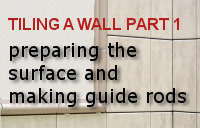
Preparing the walls and making guide rods |
 |
Welcome to our guide to wall tiling.
In this section we will cover the preparation needed and give you some tips for setting out the tiles. We also cover how to make guide rods which will enable you to visualise the finished project.
|

|
This page is © Copyright 2001-2014 helpwithdiy.com |
|

Please note: We will accept no responsibility for any damage or injury as a result of following this guide.
For further information please see our disclaimer, a link to which can be found at the bottom of this page.
|

Preparing the surface for tiling |
Preparation is the key to achieving a great finish for your tiling project and getting the walls prepared is a vital part of this preparation.
Preparing plastered brick or block walls
Ensure all surfaces are clean, dry and free from dust/debris. Repair any cracks or blemishes using a suitable filler, always allow time for the filler to dry completely.
Remember to check for any dips or bumps in the wall's surface as this can become a problem when fixing the tiles later on. For instance, some prominent bumps/dips can cause a tile to kick out on one edge or corner.
If the plaster is new then ensure it has had enough time to dry (10-14 days depending on manufacturer), also read the tile adhesive manufacturer's guidelines as the new plaster may need a coat of primer.
Tiling on top of other tiles
If you want to tile straight on top of the existing tiles, then remove all of the grease and dirt with a suitable detergent and score the tiles vertically and horizontally with a tile scriber to facilitate a bond between the existing tiles and the new ones.
There are special adhesives available designed specifically for tiling over tiles, these adhesives can sometimes be used without scoring the existing tiles.
One thing to bear in mind when considering tiling straight over existing tiles is that the new tiles will be at least a tiles thickness proud. This can cause problems when tiling up to edges like door frames.
|
|
In the majority of cases it is better to remove the old tiles first, it makes the project more time consuming but the results can be worth the extra effort.
|

Creating the guide rods |
As with a lot of DIY tasks, the setting out of a tiling project is extremely important and shouldn't be rushed. One of the easiest ways to set out your tiles is to make yourself a guide rod out of a piece of wooden batten, this can then be used to mark out the tile positions and give you a preview of how the tiling project will look when finished.
- Divide the wall width by 2 and subtract 4cms (1.6 inches) write down this figure as A.
- Get a straight piece of batten, cut to the length of A (see above) and lay it on the floor.
- Get to hand several tiles and some tile spacers.
- With the batten in front of you mark the width of a tile spacer from the left edge of the batten.
- Now place the top left edge of a tile against the mark you just made.
- Leave that tile where it is and butt up another tile with another tile spacer in between.
- Repeat step 5 until you have placed tiles along the whole length of the batten (see fig 1.1).
- Next ensuring the tiles and spacers are tight against each other mark the batten with a felt tip pen (or similar) on both edges of each tile.
- Then using a set square, mark along the whole width of the batten with a pen (see fig 1.2).
- Now mark your batten in the middle of each tile with a different colour pen (see fig 1.2).
- Next trim the batten at the mark of the last tile on the right (no spacer).

If your tiles are taller than they are wide then make another guide rod in the same way except place the tiles length ways with their side against the batten (remember to place tile spacers inbetween). Mark this batten as height and mark the batten you made earlier as width.
|

|
In the next part of the guide we will look at finding the horizontal and vertical centres of a wall, as well as using your guide rods to work out the best positioning of the tiles.
|


|
|
|
